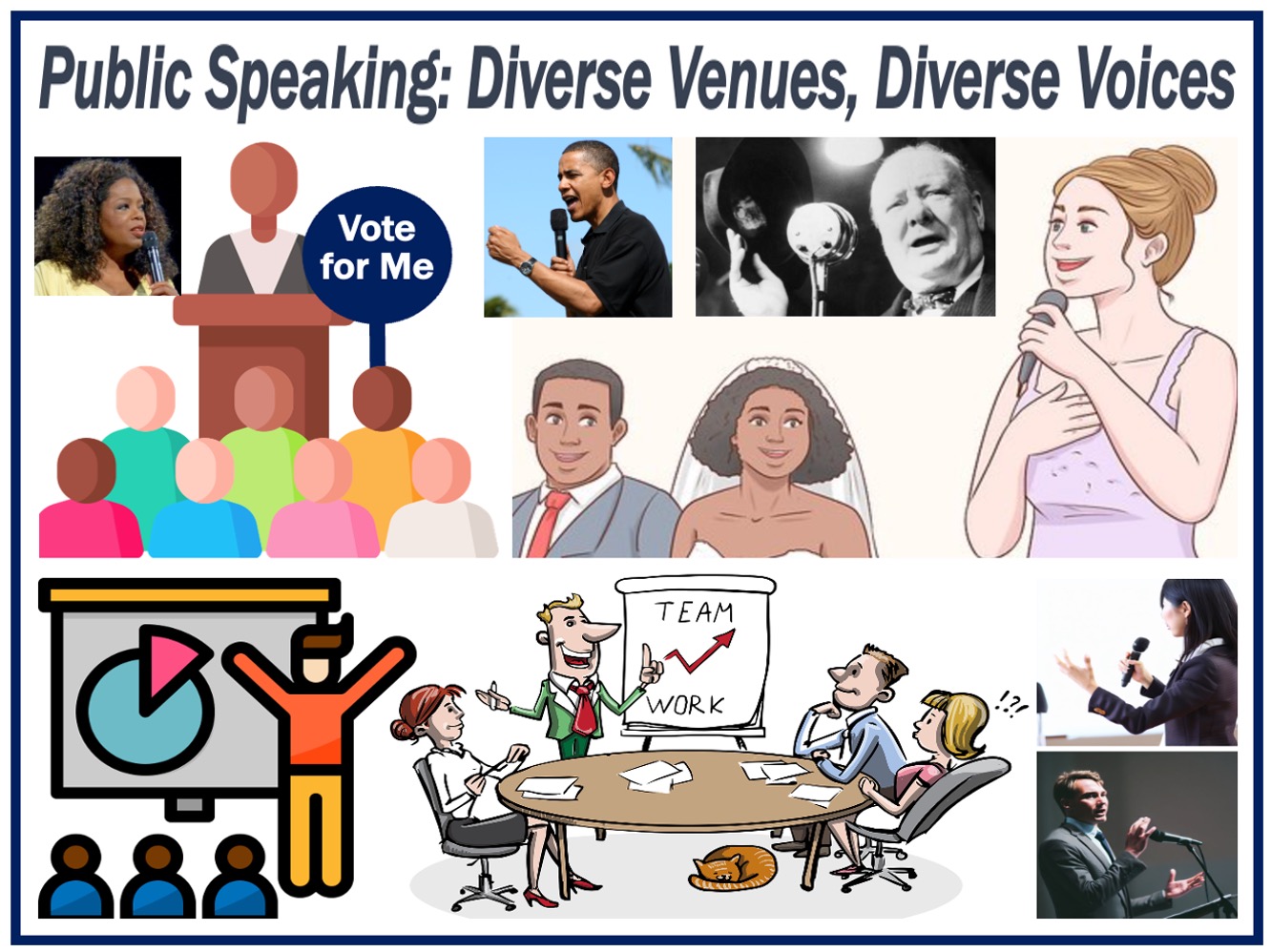The act of delivering information to a live audience is known as Public Speaking, also referred to as Oratory or Oration, though these terms are less common. This form of communication is vital in various settings, including businesses, schools, weddings, and politics. Being able to speak in front of large numbers of people is an important leadership skill.
While many people fear public speaking, with the right training, practice, knowledge, and equipment, most of us are capable of becoming excellent public speakers.
Public speaking isn’t merely about talking in front of people; it’s about organizing ideas, connecting with the audience, and effectively conveying a message.
Benefits of Public Speaking
Public speaking has many benefits for you and the people around you, including:
- Personal growth
It is great for boosting self-confidence. It can also help eliminate or reduce the fear of speaking in public.
- Career Advancement
Strong public speaking skills can be a deciding factor in employment decisions and promotions.
- Persuasion
It provides a platform to persuade or educate an audience on specific topics or issues.
Why are speeches powerful? According to abc.net.au:
“A speech can be a powerful public act. It can inspire people to be kind and more generous, or it can provoke people to hate and fear.”

Key Elements
There are many key elements of effective public speaking, such as:
- Content
Make sure you research your topic well, and that your content is relevant, organized, and well-structured.
- Delivery
The manner in which you present content is paramount. Elements such as tone, volume, pace, and clarity all play a significant role in making a difference.
- Engagement
To ensure your audience remains engaged, maintain eye contact and be attentive to their cues.
- Body language
Your posture, gestures, and facial expressions play a pivotal role in delivering an impactful speech or talk. Never turn your back on your audience!
- Visual Aids
Humans inherently respond well to visual data; it not only captures interest but also enhances retention, making it more likely that the audience will remember the presented information.
Overcoming Fear of Public Speaking
Glossophobia or anxiety related to public speaking is a real concern for many people. The following tips may help you overcome that fear:
- Preparation
Thorough preparation is the bedrock of a successful presentation. Knowing your material inside out not only boosts your confidence but also allows for a smoother delivery. Familiarity with your content enables you to adjust on the fly and handle unexpected situations, such as challenging questions or interruptions.
- Practice
It’s essential to practice your speech or presentation multiple times to ensure familiarity and fluency. Dedicate time to review, refine, and rehearse your material.
- Relaxation techniques
Deep breathing, visualization, and brief meditation can help ease anxiety. These techniques calm the mind, foster positivity, and prepare you for a confident speech.
- Positive self-talk
Replace self-doubt with constructive affirmations. Constantly remind yourself of your strengths and capabilities, using positive phrases like “I am prepared” or “I can handle this.”
- Audience engagement
Remember, your audience is comprised of fellow humans, many of whom share the same anxieties about speaking publicly. They are generally sympathetic and understanding, rooting for you to succeed rather than fail.
Tips for Success
- Understand Your Audience
Tailor your content to the interests and knowledge level of your audience.
- Engage with stories
Audiences are naturally drawn to narratives. Incorporating anecdotes or personal experiences not only makes your content more relatable but also leaves a lasting impression, ensuring your message resonates and is remembered.
- Feedback
Be open to feedback, as it helps you identify areas of improvement.
- Don’t stop learning
The art of public speaking is ever-evolving. Attend workshops, watch insightful TED talks, join speaking clubs, and immerse yourself in diverse learning opportunities. Remember, every experience can offer a lesson, so stay curious and committed to your growth.
- Limit dependence on notes
Instead of reading verbatim from extensive notes, lean on cue cards or key points from slides to guide you. This approach promotes a more organic and engaging delivery. As you grow more confident, embrace the opportunity to improvise and connect authentically with your audience.
Who popularized public speaking? According to virtualspeech.com:
“Aristotle and Quintilian are among the most famous ancient scholars to give public speaking definitive rules and models. Aristotle defined rhetoric as the means of persuasion in reference to any subject.”
Public Speaking vs. Presentation Delivery
While both public speaking and presentation delivery involve communicating to an audience, they aren’t always the same.
Public speaking is a broad term that encompasses any form of speaking to a group, whether it’s giving a toast at a wedding, delivering a eulogy, or speaking at a town hall meeting. It doesn’t necessarily involve visual aids or a structured format.
On the other hand, presentation delivery often implies a more structured approach, typically involving visual aids like slides or props. The goal of a presentation is usually to inform, persuade, or teach a specific topic or idea.
In essence, while all presentations involve public speaking, not all public speaking events are presentations.
Written by Nicolas Perez Diaz, September 6, 2023.
